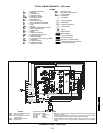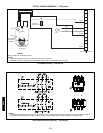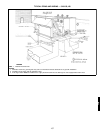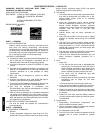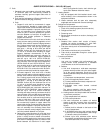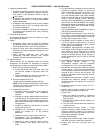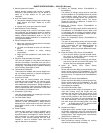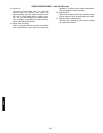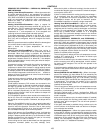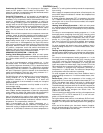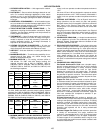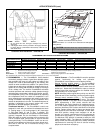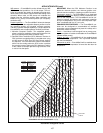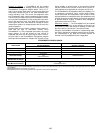163
CONTROLS
SEQUENCE OF OPERATION — 548F036-120, 549B036-120,
AND 549C024-060
Cooling, Units Without Economizer — When thermostat calls
for cooling, terminals G and Y1 are energized. The indoor-fan
contactor (IFC), reversing valve solenoid (RVS1 for sizes 024-
072) (RVS1 and RVS2 for sizes 090-120) and compressor con-
tactor are energized and indoor-fan motor, compressor, and
outdoor fan starts. The outdoor-fan motor runs continuously
while unit is cooling.
Heating, Units Without Economizer — Upon a request for
heating from the space thermostat, terminal W1 will be ener-
gized with 24 v. The IFC, outdoor-fan contactor (OFC), C1, and
C2 will be energized. The indoor fan, outdoor fans, and
compressor no. 1, and compressor no. 2 are energized and
reversing valves are deenergized and switch position.
If the space temperature continues to fall while W1 is ener-
gized, W2 will be energized with 24 v, and the heater contac-
tor(s) (HC) will be energized, which will energize the electric
heater(s).
When the space thermostat is satisfied, W2 will be deenergized
first, and the electric heater(s) will be deenergized.
Upon a further rise in space temperature, W1 will be
deenergized.
Cooling, Units With EconoMi$erIV — When free cooling is
not available, the compressors will be controlled by the zone
thermostat. When free cooling is available, the outdoor-air
damper is modulated by the EconoMi$erIV control to provide a
50 to 55 F mixed-air temperature into the zone. As the mixed-air
temperature fluctuates above 55 or below 50 F, the dampers
will be modulated (open or close) to bring the mixed-air temper-
ature back within control.
If mechanical cooling is utilized with free cooling, the outdoor-air
damper will maintain its current position at the time the
compressor is started. If the increase in cooling capacity causes
the mixed-air temperature to drop below 45 F, then the outdoor-
air damper position will be decreased to the minimum position.
If the mixed-air temperature continues to fall, the outdoor-air
damper will close. Control returns to normal once the mixed-air
temperature rises above 48 F.
If optional power exhaust is installed, as the outdoor-air damper
opens and closes, the power exhaust fans will be energized
and deenergized.
If field-installed accessory CO
2
sensors are connected to the
EconoMi$erIV control, a demand controlled ventilation strategy
will begin to operate. As the CO
2
level in the zone increases
above the CO
2
set point, the minimum position of the damper
will be increased proportionally. As the CO
2
level decreases
because of the increase in fresh air, the outdoor-air damper will
be proportionally closed.
For EconoMi$erIV operation, there must be a thermostat call for
the fan (G). If the unit is occupied and the fan is on, the damper
will operate at minimum position. Otherwise, the damper will be
closed.
When the EconoMi$erIV control is in the occupied mode and a
call for cooling exists (Y1 on the thermostat), the control will first
check for indoor fan operation. If the fan is not on, then cooling
will not be activated. If the fan is on, then the control will open
the EconoMi$erIV damper to the minimum position.
On the initial power to the EconoMi$erIV control, it will take the
damper up to 2
1
/
2
minutes before it begins to position itself. Any
change in damper position will take up to 30 seconds to initiate.
Damper movement from full closed to full open (or vice versa)
will take between 1
1
/
2
and 2
1
/
2
minutes.
If free cooling can be used as determined from the appropriate
changeover command (switch, dry bulb, enthalpy curve,
differential dry bulb, or differential enthalpy), then the control will
modulate the dampers open to maintain the mixed-air tempera-
ture set point at 50 to 55 F.
If there is a further demand for cooling (cooling second stage —
Y2 is energized), then the control will bring on compressor
stage 1 to maintain the mixed-air temperature set point. The
EconoMi$erIV damper will be open at maximum position.
EconoMi$erIV operation is limited to a single compressor.
Heating, Units With EconoMi$erIV — When the room tem-
perature calls for heat through terminal W1, the indoor (evapo-
rator) fan contactor (IFC) and heater contactor no. 1 (HC1) are
energized and the reversing valve(s) deenergize and switches
position. On units equipped for 2 stages of heat, when addi-
tional heat is needed, heater contactor no. 2 is energized
through W2. The economizer damper moves to the minimum
position. When the thermostat is satisfied, the damper moves to
the fully closed position.
Defrost (548F036-072, 549B036-072, and 549C024-060) —
As frost builds up on the outdoor coil, the coil temperature drops
below 28 F. When this outdoor-coil temperature drop is sensed
by the defrost thermostat (DFT) and the defrost timer is at the
end of a timed period (adjustable at 30, 50, or 90 minutes), the
unit operates in a defrost cycle controlled by the defrost timer
and thermostat. During this cycle, the reversing valve solenoid
(RVS) is energized and the outdoor fan shuts off. The electric
heaters (if installed) will be energized.
The unit continues to defrost until the coil temperature as mea-
sured by DFT reaches 65 F, or the duration of defrost cycle
completes a 10-minute period.
At the end of the defrost cycle, the electric heaters (if installed)
and the reversing valve will be deenergized, and the outdoor-
fan motor will be energized. The unit will now operate in the
Heating mode.
If the thermostat is satisfied during a defrost cycle, the unit will
continue in the Defrost mode until the time or temperature con-
straints are satisfied.
Defrost (548F090-120 and 549B090-120) — When the temper-
ature of the outdoor coil drops below 28 F as sensed by the
defrost thermostat (DFT2) and the defrost timer is at the end of
a timed period (adjustable at 30, 50, or 90 minutes), reversing
valve solenoids (RVS1 and RVS2) are energized and the OFC
is deenergized. This switches the position of the reversing
valves and shuts off the outdoor fan. The electric heaters (if
installed) will be energized.
The unit continues to defrost until the coil temperature as mea-
sured by DFT2 reaches 65 F, or the duration of defrost cycle
completes a 10-minute period.
During the Defrost mode, if circuit 1 defrosts first, RVS1 will
oscillate between Heating and Cooling modes until the Defrost
mode is complete.
At the end of the defrost cycle, the electric heaters (if installed)
will be deenergized; the reversing valves switch and the out-
door-fan motor will be energized. The unit will now operate in
the Heating mode.
If the space thermostat is satisfied during a defrost cycle, the
unit will continue in the Defrost mode until the time or tempera-
ture constraints are satisfied.
Automatic Changeover — When the system selection switch
is set at AUTO. position, unit automatically changes from heat-
ing operation to cooling operation when the temperature of the
conditioned space rises to the cooling level setting. When the
temperature of the conditioned space falls to the heating level
setting, unit automatically changes from cooling to heating
operation (with a 3° F deadband in between).



